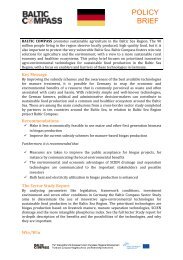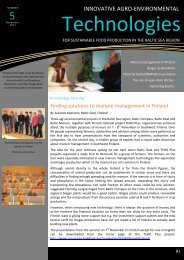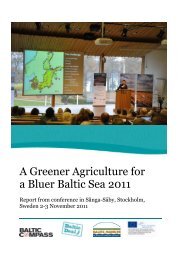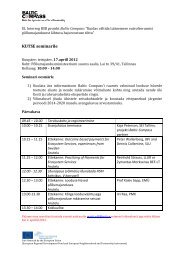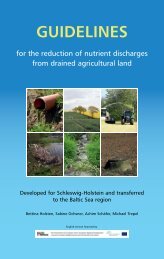Country Report Sweden (DRAFT) - Baltic COMPASS
Country Report Sweden (DRAFT) - Baltic COMPASS
Country Report Sweden (DRAFT) - Baltic COMPASS
Create successful ePaper yourself
Turn your PDF publications into a flip-book with our unique Google optimized e-Paper software.
Describe this measure in your country if different : General recommendations are:Fertiliser should not be applied to snow-covered soil outside vulnerable zones. Fertilisershould not be applied to frozen soil if there is a risk that fertiliser will be lost throughsurface run-off during rainfall, thawing of the frozen soil or snow melting. The risk of run-offlosses through cracks in the frozen soil should also be taken into account.Fertiliser should not be applied if there is a risk that, due to the soil conditions, for examplea slope, the fertiliser may be washed into nearby surface water or pollute groundwater.In areas of variable water levels, the application of fertilisers should be avoided if there is arisk of loss due to the soil being flooded or becoming waterlogged.In nitrate vulnerable zones it is prohibited to:1. apply fertiliser to waterlogged or flooded soil;2. apply fertiliser to snow-covered soil,3. apply fertiliser to frozen soil.In vulnerable zones, fertilisers must not be applied to farmland closer than two metres tothe edge of a watercourse or lake.The manure which livestock excrete onto the soil when grazing must not be included in thecalculation of the fertiliser applied. (SJVFS 2009:82)In vulnerable zones, fertilisers must not be applied to farmland adjacent to watercourses orlakes or where the slope of the land towards the water exceeds 10% (10/100).The manure which livestock excrete onto the soil when grazing must not be included in thecalculation of the fertiliser applied.191. Is there any official quantified goal that states to what extent this measure should beimplemented? Yes• If "Yes";a) specify quantity and unit: More strict rules will result in a reduced N and Pleaching from the root zone, corresponding to -30 tonnes of N and -2 tonnes ofP.b) if applicable, what year to be realized? 2013c) give reference(s): Andersson et al. 2010• If "No", what is your expert opinion of the desirable level in 5 years?quantity and unit:2. To what extent is this measure implemented today in relation to goal set above?"0"=Not at all; "10"=Goal already reached3. If goal is not reached; how do you judge the possibilities to fulfill it?"0"=Impossible; "10"=Very goodComments: Andersson, R., Bång, M., Frid, G. & Paulsson, R. 2010. Åtgärder för minskadeutsläpp. Bilaga 2. Rapport 2010:10. Jordbruksverket, Jönköping. 189 sidor.Comments on why the goal is easy/difficult to reach, what are the most importantparameters in your country:The more strict rules run from 1 january 2010. The calculationof the expected reduction in N and P leaching depends on that the rules will be followed.



